There Goes Those Knuckles Again Gator Grip
Top 10 Most Underused Techniques in MMA
0 of xi
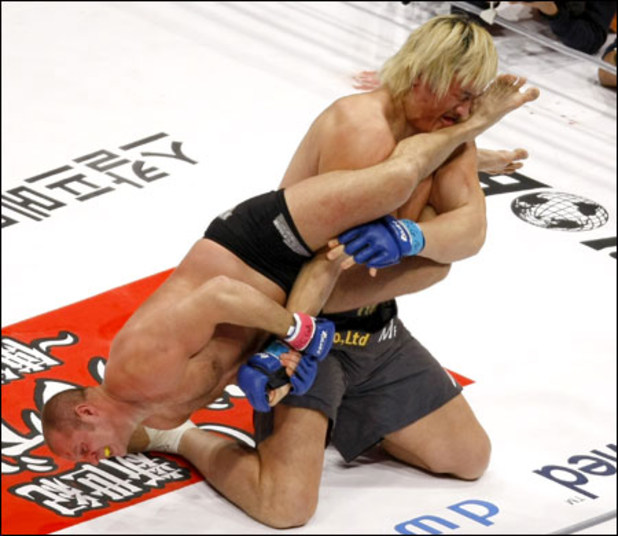
Undoubtedly one of the all-time aspects of MMA is the sheer variety of techniques that fighters tin can use during a match and this is what makes information technology then exciting and different from every other combat sport.
In that location are dozens of submissions and strikes that can terminate a fight and some of them have repeatedly been proven effective time and again.
However, there are several good moves that aren't as widely used by fighters all the same are still significant in their power to cause impairment or make the situation more favorable for one of the combatants.
My criterion of inclusion for each maneuver listed here was the motion's efficiency, ability to end a fight or amend position, relative effectiveness, degree of difficulty, and general practicality in a given state of affairs.
For the more unorthodox tactics I tried to requite a chip of background on the move's history and specifications.
I likewise made sure to provide concrete examples of each techniques previous application in MMA so every bit to justify my argument for including it.
Of form, I am in no position to exist telling professional fighters what they should or shouldn't be doing in a match.
I but feel that some moves are unnecessarily overlooked in favor of flashier or battle-tested techniques and promise that perhaps a few of these abilities volition exist used more often in time to come competition.
But I have already said too much. Let us proceed to the list.
10. Continuing Elbows
one of 11
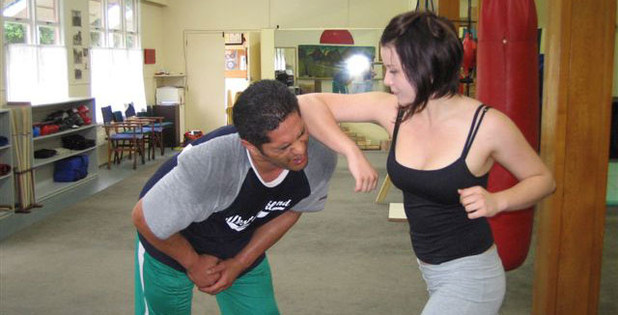
Nosotros all know the ability that an elbow strike on the footing tin generate. Yet the ability of elbow strikes to confer damage on the feet is ofttimes neglected in an MMA lucifer where a fighter would rather swing for the fences or utilize a precision punch from the outside.
Ane need not look whatever farther than Muay Thai competitions to recognize that having elbows in ane's repertoire of moves can only increase the chance of victory, and the more varied somebody'southward striking capacity is then the harder information technology volition be to stop them.
Being unpredictable is essential to catching your opponent off guard and giving yourself a better shot at knocking him out.
Standing elbows are occasionally thrown with the intention of cutting someone. They are capable of wreaking havoc in a manner that mere punches cannot contend with.
Elbows thrown with velocity towards the head tin can cause pregnant edgeless force trauma, especially since the point of impact is rigid and bony.
When delivered properly at the edge of the elbow and tip of the forearm, these types of strikes tin hurt only as much if non more than a traditional punch, and at close range or in the clinch, elbows can be downright devastating since they tin can come up across the body and don't have to be loaded like a typical dial.
With the style fighters usually encompass up, standing elbows can penetrate the baby-sit as they impact the brow whereas fighters tend to cover the side of the head and their cheeks when blocking every bit in a standard boxing baby-sit.
The elbow can state correct between the opponent's arms, and when used in conjunction with punches, is a great way to unleash a powerful combination of strikes that leaves you're opponent guessing equally to what you're going to practise next.
Strikers of all kinds would benefit from adding standing elbows to their arsenal, and they demand not remain in the domain of Muay Thai stylists.
Brock Lesnar showed the blazon of damage that an elbow strike could do confronting Randy Couture, though the former is an immensely stiff homo and even a glancing accident from him could cause a lot of pain.
In some other instance of this move's efficacy, Jason Twenty-four hours used several continuing elbows to injure Alan Belcher before finishing him with punches along the fence at UFC 83.
Those elbows actually rocked Belcher and signaled the beginning of the end of that match and this shows that even Muay Thai strikers are susceptible to falling prey to their own specialized maneuvers.
The elbow strike is non technically difficult to learn and information technology is a technique that certainly wouldn't hurt to have especially if one likes to fight upward close using dirty boxing in the clinch or during a standard necktie-upwards.
Such a strike is perfect for when two fighters are backing away from each other and an elbow is thrown unexpectedly.
One does not have to throw it horizontally either, such as when Anderson Silva knocked out Tony Fryklund with a standing dorsum elbow thrown upward with the tip every bit the point of impact.
9. Armbar from Mount Position
ii of 11
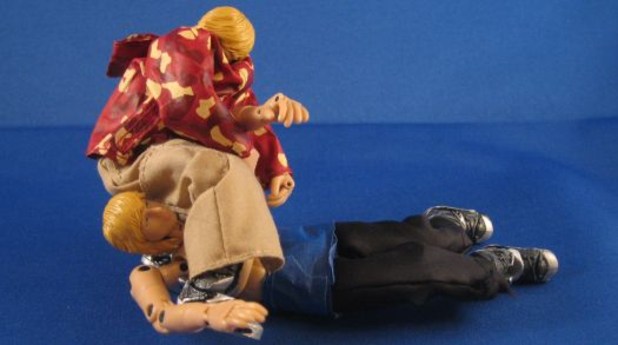
One of the about frustrating things about watching MMA is seeing a fighter in a position to end a fight but not doing so for whatever reason. I'm sure some of you have had this aforementioned experience where you yell at the television in your all-time Shao Kahn impersonation, "Finish Him!"
Of class, without this possibility, dramatic comebacks would exist impossible, but ending a fight when ane has a great opportunity is a sign of the aptitude and killer instinct that is necessary for success at the highest level of MMA.
The mountain is considered to exist the second about ascendant position there is, side by side to the back mount. In the early UFC days when a fighter got to this point the match was pretty much over.
Every bit ground defense has gotten amend and referees are less lenient to call a stoppage due to mounted punches, a greater proportion of fighters have survived later on being placed in this formerly mortiferous state of affairs.
The natural tendency afterwards achieving the mount is to rain down strikes on your opponent, either with straight punches, hammerfists, or elbows.
Yet the fighter on bottom may escape or the circular will come to a close without a conclusion to the match.
An armbar is usually right there waiting and many fighters either choose non to get for it or are not capable of delivering such a submission.
Without a doubt there are jiu-jitsu techniques that are more difficult to execute than a mounted armbar, and y'all certainly don't need to be a brown or black chugalug to execute such a move.
Why do fighters sometimes non get for the armbar when their opponent'south arm is flailing in the air, begging to grabbed and hyperextended?
Well, the human being on meridian may not desire to run a risk losing his position. Surely, if he cannot finish the fight via strikes from the mount, and if he has been in that position for a considerable amount of fourth dimension or the clock is well-nigh to run out, wouldn't taking the take a chance be worth information technology?
The armbar from mount is really an essential maneuver since everybody volition find themselves in that position eventually and knowing how to finish properly is a great asset. Even though it takes a bit of speed and precision to pull off accurately, information technology can definitely be learned past near anybody who is serious about the sport.
If one is quick plenty in his transition this type of armbar has a high success rate. The primal is to deceive your opponent and wait for the opportune moment to commit.
A savvy fighter will allurement his opponent into grabbing his arm and so that he tin reverse the position when the other man commits.
Yet, the purpose of the match is to win, and some fighters are more comfortable throwing condom punches from the mount in gild to secure a technical knockout victory.
Finishing a fight has its benefits, and more than than a few fights would have ended differently if the man on top had gone for an armbar instead of letting his opponent survive the mounted position.
That is why I think information technology is one of the more than underutilized submissions in MMA.
8. Body Strikes
3 of 11
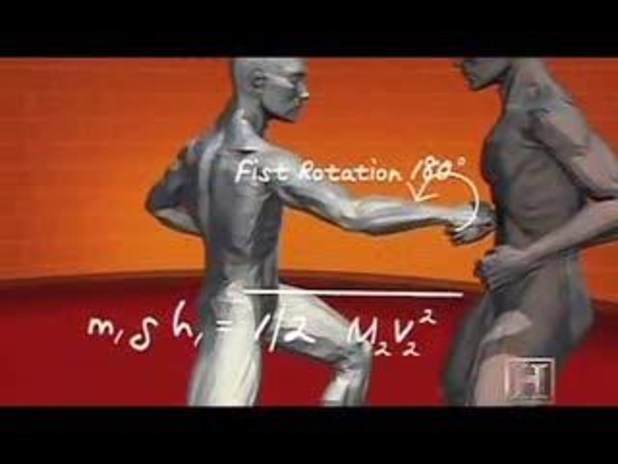
Punches to the body course a staple of the boxer'southward arsenal, however this tactic is very much underemployed in the MMA world.
Often, fighters are all-too eager to stand and merchandise with each other, throwing hooks and haymakers to the mentum in an endeavor to score a crowd-pleasing knockout and perhaps secure a fight of the nighttime fiscal bonus.
While this is an beauteous endeavor, as fighters try to put on a show and option up extra cash, body strikes are frequently neglected in these stand-up exchanges since it is easier to become a knockout with a strike to the chin or temple.
Though non as flashy as a wild hook or swinging haymaker, body punches and kicks have their ain place in MMA and tin can be simply as effective in bringing nigh a stop to the fight.
I am including all strikes to the body under this category, since kicks and knees to this area tin exist even more than destructive than punches, and they are weapons that a boxer does not take admission which makes it even more surprising that they are not used every bit much in MMA.
The smaller gloves used in MMA makes it harder to cover upwardly and block punches effectively. This makes the gut are an even more bonny place to land a blow since fighters will unanimously comprehend their heads when the other homo starts throwing a dial.
The benefits of throwing body strikes are quite obvious. They can wear down an opponent, make them tire more quickly, and actually take their toll over the elapsing of the fight.
Mid-level kicks tin knock down an opponent where some quick footing and pound will finish him off.
Mirko Cro Cop employed burdensome liver kicks during his tenure in PRIDE and shows how dangerous that sort of strike can be, though the downside is that one tin catch the boot and score a takedown a la Gabriel Gonzaga.
Knees to the trunk within the clinch tin force the opponent to double over, leading to a few knees to the head.
Punches and elbows to the body while on the mat can be a very effective ground and pound tactic.
Quinton Jackson used these strikes confronting Chuck Liddell in their first match and forced his corner to throw in the towel, and this was against a future UFC lite-heavyweight champion no less.
Punches to the liver or kidney from back mount tin can also strength a fighter to curl and give up the choke more than easily.
A fighter hurt by a body shot is easy pickings, though ane has to be conscientious when closing in for the stop (see Scott Smith vs. Pete Sell for proof). The floating rib is a perfect target, every bit is the liver and fifty-fifty the sternum can be damaged from a powerful hitting.
Strikes to the body tin be all that separates two combatants in an otherwise equal match-up on the feet. Some fighters have very stiff chins and are difficult to knockout or knock downwards.
In that location are fighters who leave themselves wide open for a well-timed claw or kick to the gut which can take the current of air right out of them, but the opponent does not utilize this opportunity to set on.
Fighting smart and having a skillful game plan are the keys to success. Often if a fighter is losing the first two rounds he does non try anything unlike in the 3rd and certain enough loses the fight.
Calculation more trunk strikes to one'south arsenal will make somebody'due south striking more than unpredictable and lethal. If an opponent is known for his bang-up cardio so a few well-placed trunk shots will bring his energy down a notch.
Strikes to the stomach can be thrown from all angles and whatsoever range, and there have been fighters who literally dropped to a knee to deliver such a blow.
Those who neglect to protect their cadre in a fight are begging for problem when they go up against an elite-level stand-up artist.
I think in the future nosotros will see body strikes more frequently in MMA as fighters in general improving their hitting abilities.
MMA contains a higher proportion of globe-course grapplers and wrestlers than strikers, then information technology is but natural to see that striking in general is behind the ground game.
Body shots can prove in a fight, as for example during Franklin-Hamill friction match when the onetime wasn't able to penetrate the baby-sit or chin of the latter and resorted to body strikes to take him out, proving just how useful this technique tin can exist when dealing with fighters who are good at covering up or have an outstanding chin.
seven. Pulling Guard
four of 11
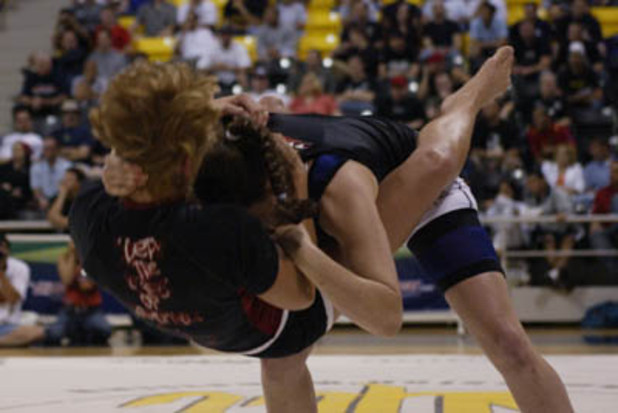
Upon commencement glance one may belittle at my inclusion of this tactic, however it is imperative for submission fighters to have a means of taking down their opponent since nearly every submission will exist completed on the ground.
Many MMA combatants are adept at Freestyle wrestling and utilize information technology every bit either a primary or secondary art. This groundwork gives them a repertoire of different types of takedowns, such as single and double-leg shots.
Greco-Roman wrestlers are experts in using sweeps, trips, and throws from the assure to accept the fight to the mat.
However, other fighters had to adapt and borrowed the sprawl to counter these types of moves. And some competitors are difficult to control or get a hold of in the clinch, making it most impossible to have them downwards with a traditional trip or sweep.
Pulling guard is a technique by and large utilized past Brazilian Jiu-jitsu fighters who are either unable to accept their opponent to the mat via conventional ways or want to be on the ground in the lesser baby-sit position.
Ordinarily the man who employs this maneuver has a actually dangerous guard game with a penchant for triangle chokes, triangle armbars, omoplatas, gogoplatas, sweeps from the lesser, reversals, and more.
Information technology can be difficult to defend confronting such a tactic, because once somebody clinches with you they can fall back and elevate you to the ground. Other fighters prefer a leaping guard pull, where they will really spring and grab a agree of their opponent's waist with their legs and bring them to the mat that way.
Thus at that place are a couple different means of initiating the guard pull, just the intention is to bring the opponent within your baby-sit to await for a submission or a reversal so that one can be on top without having to execute a more traditional have down.
Against fighters with a really good sprawl and assure residue, or for grapplers with weaker wrestling skills or a lethal bottom game, pulling baby-sit can exist an splendid method for swinging the fight in your favor and moving one step closer to victory, and I call up information technology is very much an under appreciated maneuver in the MMA world.
Still, the method of pulling guard seems to exist undergoing a renaissance of its own amid prominent BJJ artists such as Shinya Aoki, Demian Maia and Vinny Magalhaes, and we have definitely not seen the last of this ancient yet anarchistic tactic.
6. Hammerfist
5 of 11

The hammerfist is most definitely nether appreciated when it comes to the basis and pound aspect of MMA.
Fighters volition often prefer to throw directly punches when inside the guard or elbows (in N America) when in side mountain or half-guard.
However, using the hammerfist can be an excellent tactic for several reasons. Since it travels downwardly at a high velocity, it has a greater corporeality of gravity behind it than a dial thrown at an angle.
This increases the corporeality of power that a hammerfist tin can generate.
Secondly, this type of strike can exist thrown in quick succession with both hands much faster than regular ground punches can, and so impairment will accumulate rather quickly.
The hammerfist tin can be used from nearly any position on the footing to attack the opponent, including when 1 has taken his opponent'south back. It can also be aimed to rather easily bypass the opponent's defence.
Even fighters on the bottom can throw hammerfists upwards towards this opponent, and often times this strike will be more effective than a regular punch from ane's dorsum.
At that place is less padding on the side of the glove towards the palm than on the knuckles, so these punches can very much hurt sombody even though they are delivered with a different part of the fist.
Combatants who are prone to breaking their hands, such as Fedor Emelianenko, sometimes prefer using the hammerfist since it takes pressure away from having to use their knuckles on a downed opponent.
The ability to strike on the footing is one of the cadre skills of whatever MMA fighter and the hammerfist is ideally suited for such a purpose.
Subsequently a knockdown, many fighters will make the error of running correct into an opponent's guard and delivering direct punches from there in an effort to finish the lucifer.
The ideal tactic in this situation would exist to bypass the opponent's guard by running to his side and deliver hammerfists from there.
Therefore this blazon of strike is perfect for finishing a fight when a fighter has been dropped due to the fact that it can exist delivered in rapid succession earlier the rocked opponent can recover.
Several fighters have demonstrated the effectiveness of the hammerfist in MMA, such equally Fedor Emelianenko, Murilo Rua, Checik Kongo, Takanori Gomi, Brock Lesnar, Renato Sobral, and others.
Nonetheless, a lot of competitors are still unable to deal whatsoever significant damage within an opponent'south baby-sit, and adding the hammerfist as a principal technique would help to assuage this state of affairs.
The match between Renato Sobral and David Heath is a perfect example of how to utilise hammerfists in addition to standard punches to hurt the opponent from the meridian guard position.
Most of Fedor's fights in PRIDE FC were also grand displays of the hammerfist'southward effectiveness, and it's simply natural that 1 could acquire a thing or two by watching the best in the sport compete.
five. Butterfly Guard
vi of 11
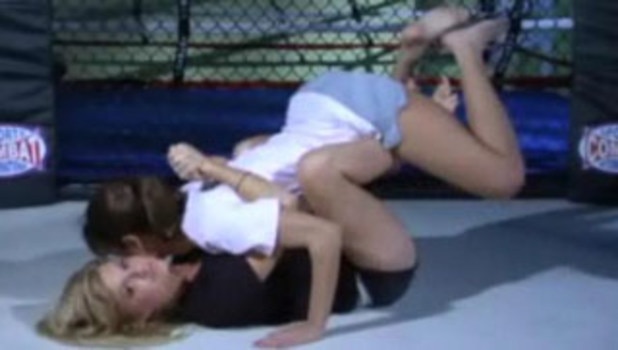
This is a blazon of open up guard whereby the man on bottom keeps his legs in between the thighs of the other fighter and hooks the top of his feet onto the inside thighs for stability.
The butterfly guard is excellent for keeping the peak man unbalanced in his posture and thus unable to execute any effective footing and pound.
It is perfect for delivering what is chosen an elevator sweep which is when the lesser fighter kicks his legs up from underneath the opponent and pushes the top man off of him vertically and then towards the side.
This blazon of sweep can reverse positions on the ground or outcome in both fighters support on their feet.
The baby-sit itself provides for many different variations and each form has its ain advantages and disadvantages.
The one bully attribute for the butterfly guard is that it gives the human on bottom greater leverage and the ability to escape the position via a well-timed sweep or reversal in a manner that other forms of the guard do non allow.
Too often a fighter will remain in the closed guard not really doing anything while hoping for a stand-up, but this guard is an try to convalesce that situation by providing a better hazard to escape while minimizing punishment and giving oneself greater command of the other fighter's posture and balance.
The butterfly guard is flexible in that information technology can be used as a quick transitional phase to a ameliorate position or conversely can be drawn out as a defensive stance to maintain control of the top human and negate any sort of harm.
Overhooks or underhooks are normally used in conjunction with the butterfly guard to contain the man on superlative.
The fight betwixt Jeff Joslin and Josh Koscheck is a perfect example of how the butterfly baby-sit tin can completely neutralize an opponent by making his position on superlative unstable and ineffective.
Joslin lost that lucifer, but his performance was a tour de force of what the butterfly guard can achieve when executed correctly.
The biggest weakness of the butterfly guard is that it tin be passed quickly if one is not conscientious. That is why it has been traditionally employed only by those who are skillful at Brazilian Jiu-jitsu.
However, information technology definitely has its uses and if one knows how to use the butterfly guard to its fullest extent and then they can plow the tide of the match in their favor with a sweep or minimize damage in a way that is not possible with other variations of the open guard en route to seizing an opportunity to go on the offensive.
4. Uchi Mata
7 of 11
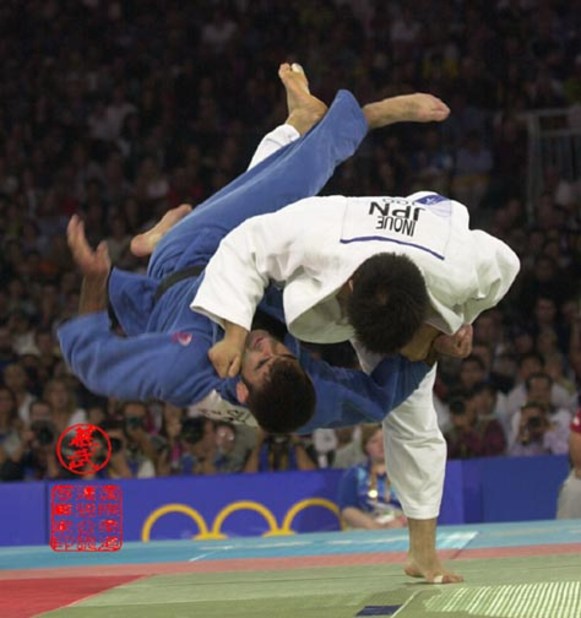
The Uchi mata is one of the most famous judo throws and it is capable of existence used in no-gi grappling without any difficulties. Information technology is like to the hip toss or head-and-arm throw seen in other grappling disciplines.
Information technology has been popularized in MMA by the Judoka Karo Parisyian and this throw has ofttimes made highlight reels out of the unfortunate opponent who suffered it.
Fighters volition ofttimes struggle to have downwards their opponent for whatever reason, whether because they have a good sprawl or balance in the clinch or smashing hip force and the like.
If a double-leg shot is not executed swiftly and so the opponent volition have fourth dimension to react and be able to stuff information technology. Similarly, it can exist difficult to sweep or trip somebody from the clinch if they are expecting such an attempt.
The great thing about the Uchi mata is that information technology can be initiated as shortly as two fighters enter close range if one is fast enough. Thus it tin can be executed swiftly and before the opponent has a run a risk to react.
It is also fantabulous for punishing over-aggressive opponents who are charging you, and so yous stop up using their ain momentum to throw them. So it can be used as a counter-move as well.
I'one thousand sure many of you have seen Parisyian throw opponents onto their head with this maneuver several times as aplenty demonstration.
In fact, when one goes upward against a Judoka like Parisyian who has adapted his style to no-gi gainsay, one tin surely look such him to attempt several Uchi mata's and set accordingly.
Withal the majority of fighters are however unable to unable to prevent high-caliber Judo practitioners from implementing this technique during a match, showing just how effective it can exist even if i knows information technology is coming.
Judo is unremarkably practiced in East Asia and many Japanese fighters utilize throws such as the Uchi mata on a regular basis. This move can be performed just equally hands with the gi every bit without it, even on a slippery opponent.
However, usage of this throw is not regulated to Judo practitioners exclusively.
Several grappling arts have a technique that is akin to the Uchi mata is some shape or grade, though possibly with slight differences in the execution.
The Uchi mata is too referred to in English language as the inner thigh throw. Nosotros have seen wrestlers in MMA such as Georges St. Pierre utilise this type of takedown to great issue.
In the unending attempt to become more than versatile and unsafe in the cage or ring, professional person fighters are always looking for new ways to improve their skills and add together to their repertoire of moves.
Having the ability to accept down your opponent is a key skill, and the Uchi mata is i of the more novel and unorthodox ways of accomplishing this task.
It certainly cannot hurt to exist able to execute such a technique, especially since it is a lot harder to defend than a traditional double-leg shot or trip from the clinch.
Thus, I think in the future we will run into Judo throws more than oftentimes in MMA as fighters strive to outdo their opponents and search for new methods to bring victory within their grasp and round out their skillset.
3. Safe Guard
8 of 11
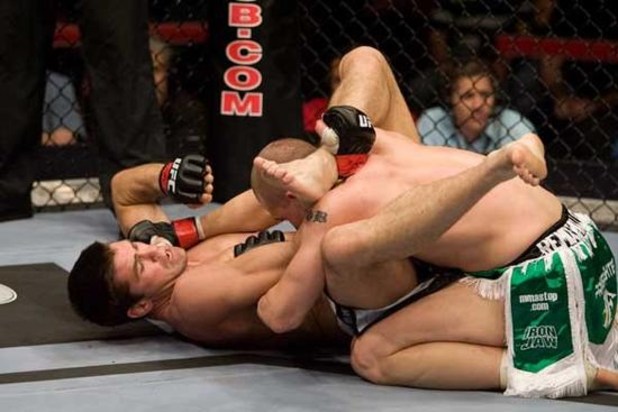
This is a version of the open baby-sit where the man on bottom wraps 1 leg around the other fighter's neck and grabs that pes with the opposite paw to pin his man downward.
From here, the lesser combatant is able to utilize his complimentary mitt for strikes, submissions, or sweeps while controlling the posture of the top fighter and preventing him grade doing any harm.
The rubber guard has been popularized by Brazilian Jiu-jitsu trainer and no-gi expert Eddie Bravo.
A blackness chugalug under Jean-Jacques Machado, Bravo was looking for a ameliorate manner to reduce damage from the guard while maintaining an ability to stay on the offensive.
He was disquisitional of the fact that BJJ practitioners relied excessively on mitt command which tin easily be broken.
Thus instead of trying to block punches or rely on meager hand control in a match he adult the safe guard which is intended to add together versatility and novelty to a BJJ fighter's arsenal.
The rubber guard maximizes the attacking and defending capabilities of the traditional open guard by limiting the opponent's movement while providing room for several different kinds of submissions.
The major downside to the rubber baby-sit is that it requires considerable flexibility to pull off convincingly.
As Bravo repeatedly insinuates, BJJ already know practitioners know that proper stretching is vital and that ane ought to be physically prepared if he expects to compete at the highest level of gainsay sports.
The condom guard is known for initiating rather exotic maneuvers such as the gogoplata and omoplata, but it tin can also lead to higher-percentage maneuvers such equally traditional triangle chokes, armbars, reversals and different kinds of strikes with ane'southward costless paw like elbows and upward hammerfists.
Another reason why the rubber guard can be constructive in MMA is because it was developed with Bravo'south no-gi philosophy in heed, as opposed to other types of guards that principally rely on the gi for their expediency and thus don't translate as well into MMA.
A perfect example of the applicability and efficiency of the rubber baby-sit is evidenced in the fight betwixt Jason Day and Alan Belcher at UFC 83 (pictured).
Day trapped Belcher within this guard and rained down ten elbow strikes and seventeen unanswered punches. He so won on the lucifer on the feet via TKO.
Belcher was unable to mount whatever sort of offense any when he was caught inside the rubber guard and sustained quite of bit of punishment which softened him upwards for the stop.
That friction match was one of the best displays of the rubber baby-sit'south efficiency in MMA and I'yard certain Bravo was impressed past Day's performance.
BJ Penn is fond of using the safe guard, and several other fighters have used it in MMA to successfully lock in gogoplatas, such as Shinya Aoki, Nick Diaz, and Brad Imes.
Though the gogoplata is admittedly tricky to pull off, and the omo plata is primarily used every bit a sweep, equally I mentioned there are numerous techniques that the safe guard can set-upwards and it can even branch out into dissimilar sub-variations which farther increase its potential.
It is a highly unique modification of the open up guard and in the right easily (or legs) the rubber baby-sit tin can be a deadly tool.
Though information technology may non be for the faint at centre, chances are that in the time to come we will be seeing this type of guard used with greater frequency often in one case noesis of this technique improves and fighters become more good at implementing it into their basis game.
2. Anaconda Choke/Brabo/D'arce/Shaolin Asphyxiate
9 of 11
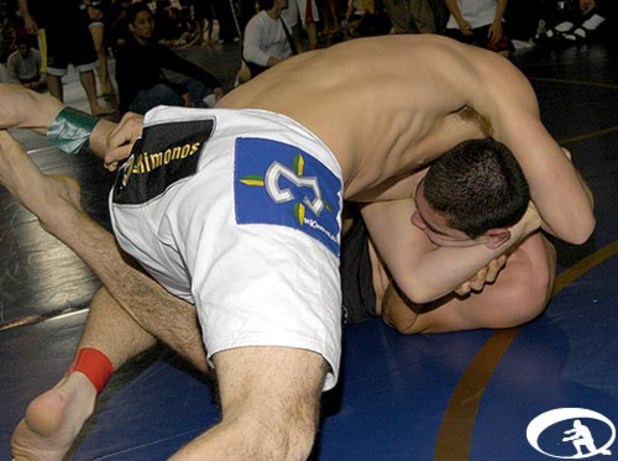
These are variations of the standard arm triangle or caput-and-arm choke. The Anaconda is a divide movement, while the Brabo (pictured), D'arce and Shaolin choke are dissimilar names for the same submission, and they are unique from the Anaconda.
Modifications of the arm triangle can exist employed from the half-guard (peak or bottom), baby-sit (lesser), side mount, north-south position, referee'due south position or from a front headlock on the ground.
They are versatile in their application and are especially useful in North American promotions where knee strikes to the head of a downed opponent are banned, thus leaving the manner for some creativity when it comes to upper-body submissions.
These types of submissions are nearly successful against opponent's who aren't as experienced on the ground and are therefore less prepared to defend against an advanced maneuver.
Of form, top-tier grapplers tin still get caught in such a choke, only they are admittedly harder to pull off than more than bones techniques.
However, when such a asphyxiate is properly locked in the lucifer is pretty much over; equally opposed to a tight guillotine which still can exist escaped.
The Anaconda choke made its MMA debut at the hands of Antonio Rodrigo Noguiera when he submitted Hirotaka Yokoi and Heath Herring consecutively in PRIDE FC in 2004 with information technology.
Rodrigo and his brother Rogerio learned the Anaconda from BJJ instructor and fellow black belt Luiz "Buscape" Firmino, a human who has competed in PRIDE FC and DREAM every bit a lightweight.
It was made famous stateside past Renato Sobral who used it to finish off a bloody David Heath and then refused to permit go of information technology, leading to his eventual dismissal from the UFC.
The Anaconda is absolutely less versatile than the Brabo asphyxiate, since information technology tin can actually but exist performed from the front headlock position. All the same, with all of the takedown attempts and sprawls in MMA, such a position is quite common.
The man on pinnacle proceeds to thread his arm under the opponent's neck and through the armpit, and grabs the bicep while locking his own arms together.
The fighter and so pushes downward to create pressure and squeeze his opponent'southward neck. The prosecutor will unremarkably do a gator curl to solidify the choke en route to making his opponent tap or get unconscious.
The Brabo choke was named past prominent BJJ teacher and author Kid Peligro, and he chose it because "brabo" ways aggressive or vehement in Portuguese. It is basically a reverse caput-and-arm asphyxiate and was originally used with the gi.
So Brazilian lightweight Vitor "Shaolin" Ribeiro started utilizing it with swell success in MMA and BJJ competitions and on the Westward declension it became known equally the Shaolin Choke.
The D'arce nomenclature became mutual when ane of Renzo Gracie's students, Joe D'arce, began to employ the technique liberally, though he utilized a gable grip to sink it in (a gable grip is a way to clasp your easily together when grappling).
Substantially they are however technique and the fashion to do it is past threading the choking arm under the near arm, in front of the neck, while your other arm goes overtop your opponent's head to cinch in the lock.
Kendall Grove used the D'arce choke against Alan Belcher at UFC 69, while Renato Sobral used the Brabo to defeat Sokoudjou at Disease: Day of Reckoning.
Due to the versatility of these submissions, the difficulty of defending against them and the dominion against knees to the head of a downed opponent in Northward America, I think they are extremely effective and will be used more ofttimes in the near future.
The standard arm triangle is an excellent maneuver, but the more variations you tin can put on a submission the better your chances are of winning with information technology and that is why I have the Anaconda/Brabo/D'arce/Shaolin choke equally the second most-underutilized technique in MMA.
i. Heel Hook
10 of 11

The heel hook is probably the almost feared submission in the martial arts world, and rightly so. It is banned in some submission tournaments at the novice and beginner levels.
This is because the heel hook has the ability to tear knee and ankle ligaments, shatter the tibia, rupture the knee joint, and dislocate the talocrural joint.
The reason why the heel hook is capable of such damage is considering it does not rely on hyperextension like other limb submissions, and instead depends on the rapid torquing of the knee in a management it is not suppose to go.
At that place is no gradual application of force per unit area similar in an armbar or kneebar. Thus, the nervus endings in the knee joint aren't pinched, and os damage is washed before any existent sort of hurting is felt.
It can be difficult to submit in time when a heel hook is applied properly and efficiently, because 1 feels that he is not in problem and so a 2nd after an injury can occur.
A fighter must know when to tap out lest he gets himself hurt, simply accidents practice happen and competitors aren't always able to submit earlier any impairment is done.
1 problem with the heel claw though, and the major reason why it is not used as often as it could be, is the completion percentage when one goes for it, compared to other more secure submissions, and fighters are understandably hesitant to try a lower-per centum endeavour.
One might not be able to get it locked in properly or isolate his opponent;due south torso to preclude escape or not apply it quickly enough so that his opponent sees it coming and gets his leg out of the manner.
When attempted unexpectedly, such as when a fighter suddenly falls back from the guard into a leglock position or in the middle of a scramble betwixt the 2 combatants, the heel hook tin can be a speedy and devastating way to terminate a fight.
Thus, the element of surprise and the need to tap out quickly when applied means that the heel hook tin can end a seemingly neutral fight within a couple of seconds.
Sometimes a fighter will go for this submission early on in the lucifer, and if he misses then the fight will just end up on the feet once more or the guard position will be reversed.
If somebody is en route to losing a decision, a heel hook out of nowhere tin can plow the tide. A properly executed heel claw volition forcefulness a tap or generate severe limb damage, and oftentimes at that place will be consequences even if the fighter taps correct away.
Ken Shamrock used this submission in his early bouts to great success, but information technology soon went out of way.
Notwithstanding, I call back leglocks in general are making a renaissance in MMA under the auspices of fighters such as Rousimar Palhares, Manny Gamburyan, Joe Lauzon, Masakazu Imanari and others who are non agape to try a rather unorthodox technique in order to end a fight early on and decisively.
On the first episode of The Ultimate Fighter ix, a heel hook concluded two fights out of viii and they both occurred during a transition on the ground where the heel hook is an opportunistic movement to attempt.
Of course, these two victims may not take had the best submission defence force in the world, but even the best tin can get caught in such a lock if they are not careful.
The heel hook tin can be harmful simply it is legal and can be dedicated if one is prepared and knows what he is doing.
I call up that information technology will be used more often because the worst that can happen is that a fighter will give up his position on elevation in the guard or in a scramble, but the potential of stopping the fight and ensuring a tap when done properly often makes it well worth the risk.
Therefore the heel claw's speed, effectiveness, impairment potential, and ability to forcefulness a tap and finish the fight unexpectedly are the reasons why I think it is the about underrated and underutilized technique in MMA.
Plus who can forget Ryo Chonan's ballsy flying scissor heel hook against Anderson Silva in PRIDE FC, when the Japanese fighter had the current pound-for-pound prince borer like a river dancer?
Fin
11 of 11
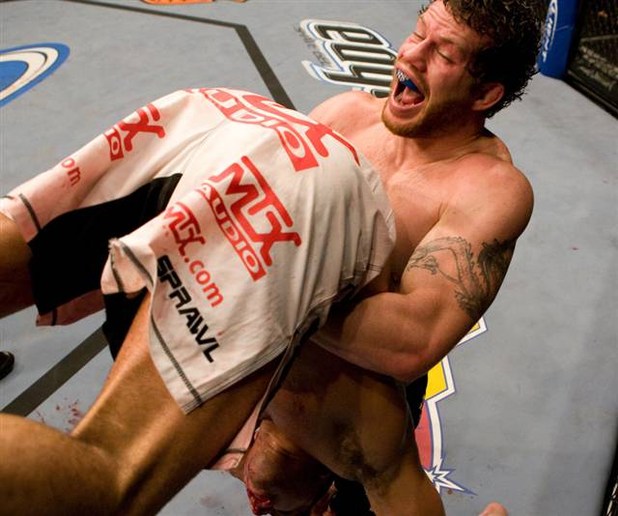
I hope that MMA fighters from all backgrounds volition continue to introduce and add new moves to their arsenal.
About every martial art has something constructive to offer, and the more techniques one has at his disposal the more dangerous and better he tin be equally a fighter.
Competitors in all sports have to requite themselves the best chance of winning possible, and an athlete can never have as well many skills. After all, multifariousness is the spice of life!
Source: https://bleacherreport.com/articles/157853-top-10-most-underutilized-techniques-in-mma
0 Response to "There Goes Those Knuckles Again Gator Grip"
Post a Comment